Last updated on February 13th, 2023 at 05:22 pm
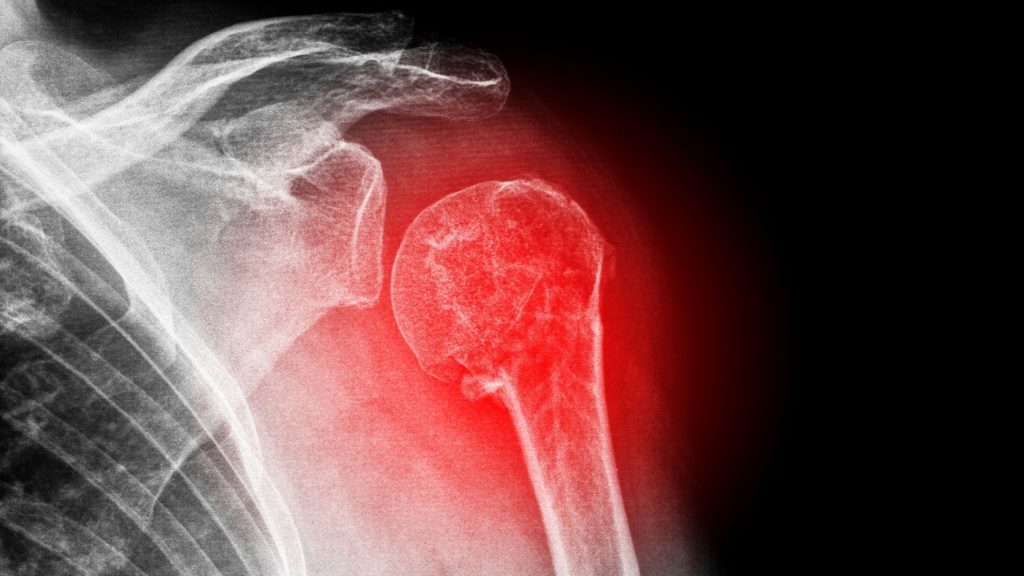
The most common complaint in greater tuberosity fracture and after removal of shoulder sling is pain and stiffness of the shoulder. You are unable to comb your hair, even it becomes difficult to hold a glass of water. This is why greater tuberosity fracture rehabilitation is very important after sling removal.
In this article, we will discuss greater tuberosity fracture physiotherapy and rehabilitation in detail, but let us start with this case study you relate yourself to.
Greater tuberosity fracture rehabilitation
Although, this fracture can occur in all age groups but is commonly seen in the elderly. Actually, greater tuberosity is a plateau-like projection on the upper end of the humerus (arm bone) bone. It is the insertion point for the muscle around our scapula ( Supraspinatus muscle, Infraspinatus muscle, teres minor muscle). In greater tuberosity fracture this plateau-like structure is fractured.
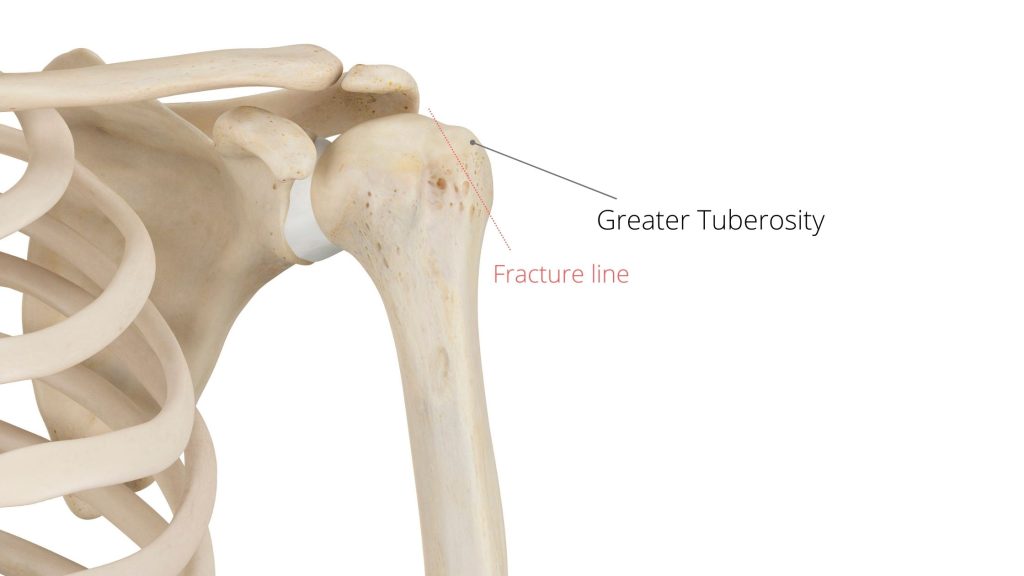
Depending on the force and cause of fracture, the fracture segment may remain displaced or un-displaced. But before going deeper into it, let us first take a case study to better connect to it.
A case study
A 40 years old female school teacher came to us with a complaint of a painful left shoulder with restriction of shoulder movement. She had a history of injury on top of the shoulder around 2 months back when she fell down from the rickshaw.
Upon examining the X-Ray doctor came to a diagnosis of fracture greater tuberosity of humerus bone. The doctor immobilised the shoulder using a shoulder sling for 3 weeks. After the removal of the sling, the shoulder joint was in great pain with severe stiffness. The slightest of joint movement would trigger great pain and
What Causes fracture greater tuberosity
1: Contusion injury
Contusion injury occurs due to a direct blow on the tip of the shoulder. It can be, fall on the tip of the shoulder as described in the case study discussed in the introduction. Or it may be due to direct assault. This type of injury results in an un-displaced fracture where the fractured segments remain un-displaced.
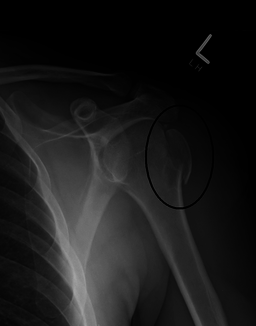
2: Avulsion injury
This occurs when shoulder muscle contracts violently and the arm goes for forceful adduction. The two forces result in the pull of a chunk of bone (GT) from the insertion point. It gives rise to displaced fracture where fracture segment gets displaced from each other.
Exercises after greater tuberosity fracture
After the fracture, the shoulder joint is immobilized in a sling for roughly one to one and half months. It is during this immobilisation period most of the complication develops and the most common of them is joint stiffness and pain. Sometimes swelling also develops in the forearm and hand. These complications are manageable if we start an early joint movement when still the shoulder is in the sling.
Exercises during early recovery phase
Although we do not permit movement around the shoulder joint, we recommend starting range of motion exercises immediately in the distal joint to avoid joint stiffness. Since the shoulder needs to be in rest, during the period of immobilisation wrist and finger movement is encouraged. Here are a few exercises that I commonly prescribe to our patients.
Wrist flexion extension
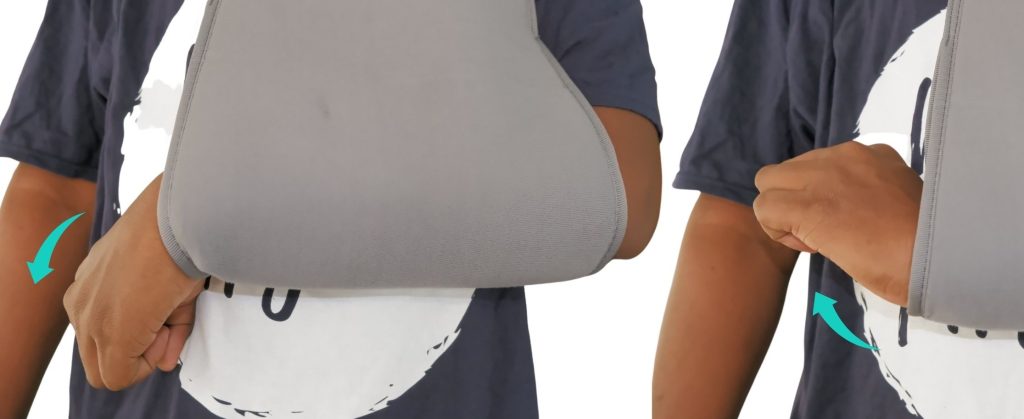
With a shoulder sling on, we can do a number of wrist joint exercises. The most common of the wrist joint is flexion and extension of the wrist. In this exercise, you have to simply move your wrist up and down a minimum of 20 to 30 times in a session. However, the more you do the better it is.
Perform this exercise whenever it is possible, there’s no specific count. This will not only prevent stiffness of the wrist joint but also help improve blood circulation in and around the forearm.
Wrist joint circumduction
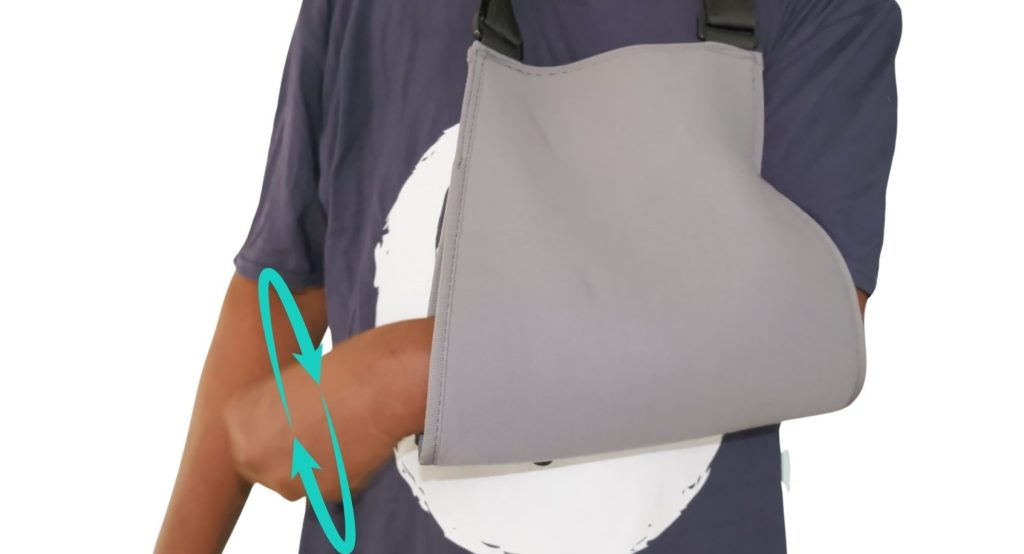
This is another wrist joint exercise important for maintaining the wrist joint range of motion. In the wrist circumduction exercise, you have to simply rotate your wrist in both clockwise and anticlockwise directions.
To make it more effective you make use of the opposite hand and hold just proximal to the wrist joint to give a nice base of support to perform circumduction. Do it for a minimum of 20 to 30 times in a session, however, the more you do the better. Do it whenever you are ideal or simply watching television.
Soft ball squeezing

Sling immobilisation for 6 weeks can make your grip strength weak. We have to take care of this also, for this we simply need a grip strengthening gel ball. Squeeze this ball as many times as possible while your forearm is comfortably supported inside the sling.
There’s no routine for this exercise, do it whenever it pleases you and any many times as you can. An important exercise to not only take care of weak grip but also helps disuse atrophy of the muscle around the wrist and forearm. It also promotes blood circulation.
Exercises after shoulder sling removal
After 3 weeks the shoulder sling is removed and after this, the most common complaint is shoulder pain & shoulder movement restriction. It is due to a condition known as painful arc syndrome. When you go to your physiotherapist they will devise a treatment plan to control pain and gain shoulder movement.
Shoulder elevation exercise
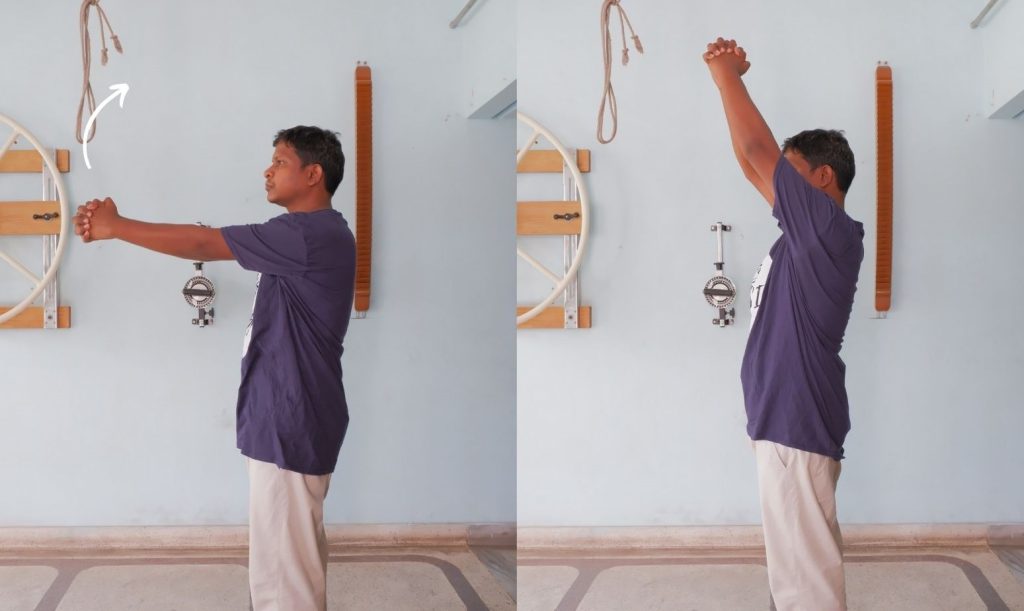
This is the most basic shoulder stiffness exercise that is recommended for every shoulder condition. The starting position for this exercise is standing straight with both hands clasped in front of yourself. Now, slowly raise your shoulder to the maximum possible point and then lower it down slowly.
Initially for a few days, due to pain, you may not be able to raise the shoulder completely, but slowly each day you need to increase it. Do it for a minimum of 15 to 20 repetitions in a single session.
Shoulder rope & pulley exercise
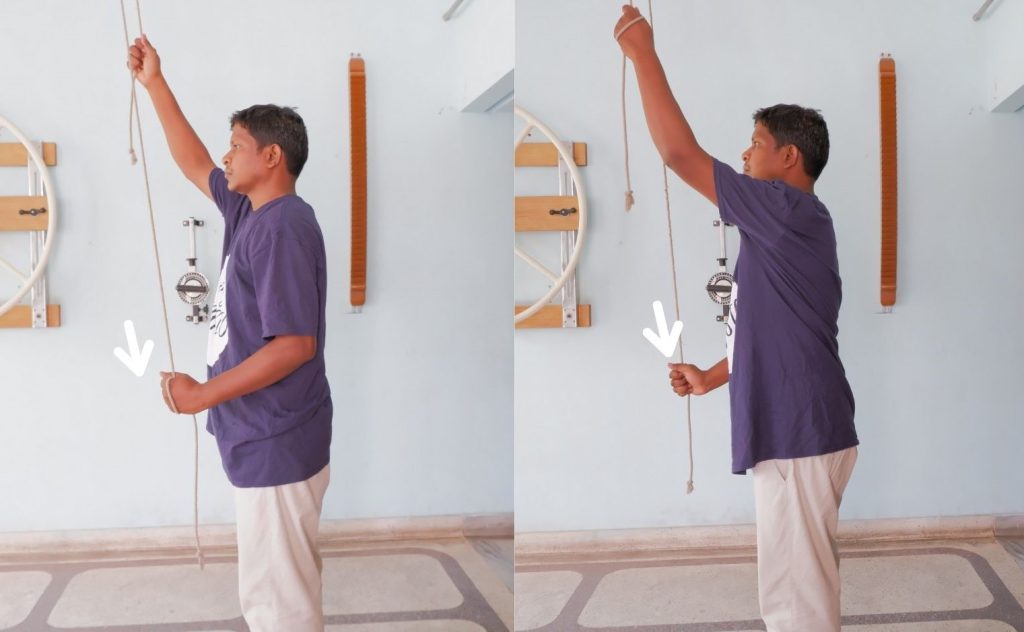
For this exercise, we need a shoulder rope and pulley system. As you can see in the figure, the subject is holding the rope and the pulley is fixed on the roof. Now pull one hand downward so as the other shoulder elevates and take it to the maximum possible pain-free point.
After reaching the maximum possible point, lower this shoulder and pull the rope downwards so that the other side shoulder elevates. Repeat this alternate shoulder elevation a minimum of 20 times in a single session.
Other shoulder stiffness exercises
Exercises have to be carried out in the line of shoulder stiffness exercises. One must make a routine to do the exercise once in the morning and once in the evening. About shoulder stiffness exercises we have already discussed in detail.
- 4 Best Shoulder wand exercises for painful, stiff shoulder
- Do These 5 Easy Band Exercises For Shoulders To Fix Pain Quickly
- How do you loosen tight shoulders?
The author is a physiotherapist who has been practising for the last 17 years. He holds a Bachelor's in Physiotherapy (BPT) from SVNIRTAR (Swami Vivekananda National Institute of Rehabilitation and Research), one of the prestigious physiotherapy schools in India.
Whatever he learns dealing with his patient, he shares it with the world through blogs and e-books. He also owns a YouTube channel, "Sunit Physiotherapist" with over 8 lakh active subscribers. Here, he shares everything he gets to learn serving the patient.
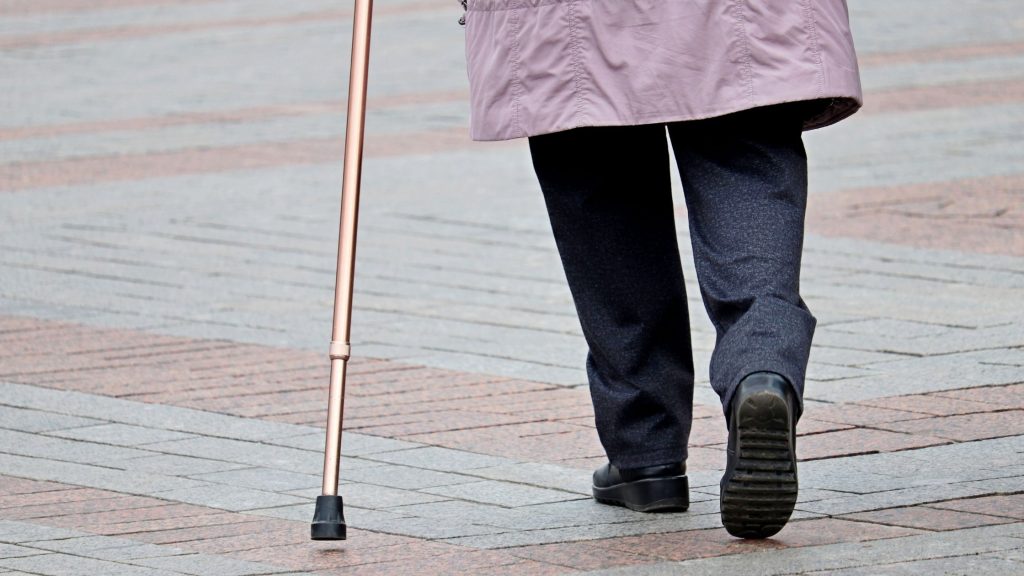




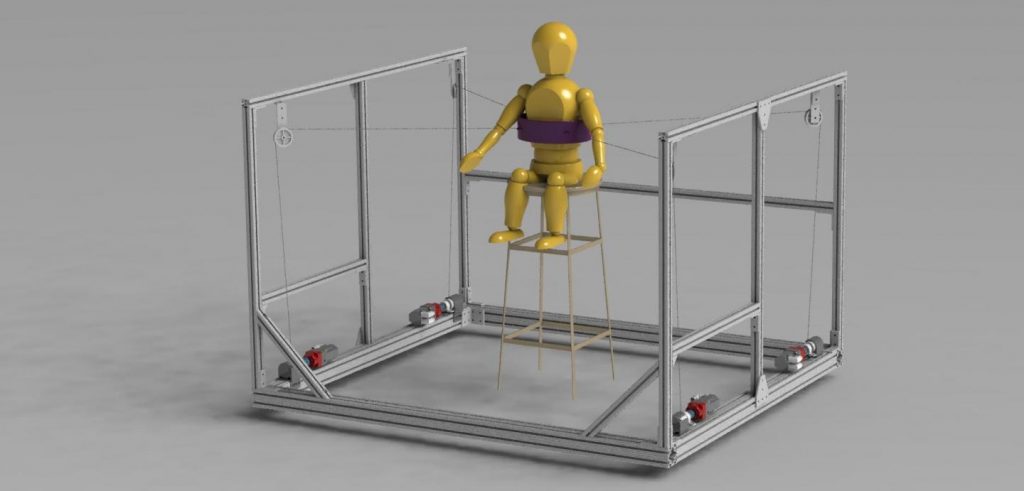
Some times it takes more than 6 months
hi still in pain 4 months on
an awesome article i have ever seen on internet medium wave brush
You completely match our expectation and the variety of our information.shoulder physical therapy exercises
In my opinion, top shoulder braces helps supporting the shoulder and helps reducing pain and inflammation, without causing any harm. Have tried it practically.